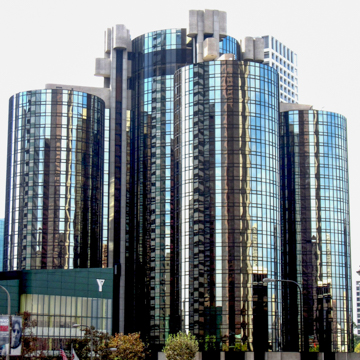You are here
Westin Bonaventure Hotel and Suites
Sometime in 1984, after struggling to locate the entrance and then the check-in desk in the vast, inscrutable Bonaventure Hotel in downtown Los Angeles, cultural theorist Fredric Jameson had an epiphany. In a massive atrium that causes confusion that verges on the sublime, feeling immersed “up to your eyes and your body” with sensory input—there and then, Jameson claims, is contained the definitive postmodern crisis: the bewildering irresistibility of late capitalism.
The impenetrability of the Bonaventure Hotel begins outside. Five circular turrets of bronzed glass arrayed on a concrete podium literally and symbolically reflect the surrounding sprawling globalized city. The mirrored exterior also obscures the hotel’s interior spatial arrangement, presenting instead a group of inwardly oriented, fortress-like drums. At street level, pedestrians are confronted with formed concrete, both ahead and extending angularly overhead at entrances on Flower and South Figueroa streets. The Flower Street entrance, however, is not original: when the hotel opened in 1976, entrance was only possibly via pedestrian bridges from adjoining buildings or by the hard-to-locate South Figueroa door. This required guests to descend a half or whole floor to reach hotel reception, an arrangement that contributed to Jameson’s (and reportedly many others’) confusion upon entry. The Flower Street entrance, added in 1986, allowed same-level access to the lobby and was also an attempt to respond to criticism that the hotel turned its back on the street.
Inside the six-story central atrium tower of the Bonaventure one encounters a self-contained micro-city, with 1,354 hotel rooms and acres of retail, restaurant, and convention space. Glass elevators rise up from the landscaped indoor “lake” through the atrium and also up the exterior of the towers—bringing the outside in, the periphery becoming central in a metaphor for the postmodern city itself. The interior walls of the atrium resemble facades, again reiterating the sense that the Bonaventure is a totalizing environment and a city within the city.
Moving through the atrium Jameson became disoriented by the arrangement of the towers—symmetrical and indistinguishable—and the feeling of depthlessness, or superficiality, created by the artificial landscape. He argued that this experience of architectural disorientation was akin to the experience of Los Angeles itself, and, significantly, to the increasing inability to map oneself in a global capitalist system. In other words, the entire postmodern, late-capitalist condition appears in the engulfing world of the Bonaventure, creating a hyperreality that is more real than reality itself. One cannot help but be overwhelmed, even subdued.
Jameson’s analysis of the Bonaventure signaled the start of the spatial turn in cultural theory and galvanized a debate in urban geography about the many manifestations of postmodernism. The account also denotes a particular moment in the history of architectural interpretation and cultural critique: when a building perceived to function improperly was accorded significance beyond negative criticism.
References
Jameson, Fredric. “Postmodernism and Consumer Society.” American Studies29, no. 1 (1984): 55-73.
Davis, Mike. “Urban Renaissance and the Spirit of Postmodernism.” New Left ReviewI, no. 151 (May-June 1985).
Rice, Charles. “Stalking John Portman.” AA Files64 (2012): 21-29.
Writing Credits
If SAH Archipedia has been useful to you, please consider supporting it.
SAH Archipedia tells the story of the United States through its buildings, landscapes, and cities. This freely available resource empowers the public with authoritative knowledge that deepens their understanding and appreciation of the built environment. But the Society of Architectural Historians, which created SAH Archipedia with University of Virginia Press, needs your support to maintain the high-caliber research, writing, photography, cartography, editing, design, and programming that make SAH Archipedia a trusted online resource available to all who value the history of place, heritage tourism, and learning.














